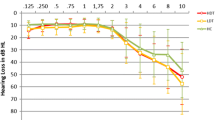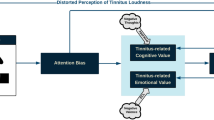Abstract
Subjective tinnitus (hereafter tinnitus) is often considered and studied as a perceptual phenomenon. Accordingly, various abnormalities in the area of cognitive processing have been reported in patients with tinnitus. At the same time, the disorder is characterized by considerable emotional distress, which is associated with a high comorbidity of affective disorders. Here, we aim to outline the close link between cognition and emotion, and how current research from the field of cognitive neuroscience examines the processing and acquisition of emotional stimuli. The emotional valence of stimuli can be acquired after brief exposure to learning, leading from neutral to appetitive or aversive evaluation. In contrast to neutral stimuli, emotional stimuli attract attention very early (about 100 ms) during processing, leading to deeper processing and corresponding memory effects. The involved subcortical and cortical network encompasses limbic and sensory areas. In particular, prefrontal regions are involved in the acquisition and evaluation of emotional stimuli as also shown in studies of patients with affect disorders. The interplay of cognitive and emotional processes seems to be central to the development, maintenance, and treatment of tinnitus.
Similar content being viewed by others
References
Alexopoulos J, Steinberg C, Liebergesell-Kilian NE et al (2019) Biased emotional attention in patients with dental phobia. Eur J Neurosci 49:290–302
Barrett LF (2017) How emotions are made: The secret life of the brain. Pan Macmillan
Brockelmann AK, Steinberg C, Dobel C et al (2013) Affect-specific modulation of the N1m to shock-conditioned tones: magnetoencephalographic correlates. Eur J Neurosci 37:303–315
Brueggemann P, Mebus W, Boecking B, Amarjargal N, Niemann U, Spiliopoulou M, Dobel C, Rose M, Mazurek B (2022) Dimensions of tinnitus-related distress. Brain Sci 12(2):275. https://doi.org/10.3390/brainsci12020275
Brunoni AR, Chaimani A, Moffa AH et al (2017) Repetitive transcranial magnetic stimulation for the acute treatment of major depressive episodes: a systematic review with network meta-analysis. JAMA Psychiatry 74:143–152
Davidson RJ (2003) Seven sins in the study of emotion: correctives from affective neuroscience. Brain Cogn 52:129–132
De Ridder D, Adhia D, Langguth B (2021) Tinnitus and brain stimulation. Curr Top Behav Neurosci 51:249–293
De Ridder D, Elgoyhen AB, Romo R et al (2011) Phantom percepts: tinnitus and pain as persisting aversive memory networks. Proc Natl Acad Sci U S A 108:8075–8080
Dixon ML, Thiruchselvam R, Todd R et al (2017) Emotion and the prefrontal cortex: An integrative review. Psychol Bull 143:1033–1081
Domschke K, Zwanzger P, Rehbein MA, Steinberg C, Knoke K, Dobel C, Klinkenberg I, Kugel H, Kersting A, Arolt V, Pantev C, Junghofer M (2015) Magnetoencephalographic correlates of emotional processing in major depression before and after pharmacological treatment. Int J Neuropsychopharmacol 19(2):pyv93. https://doi.org/10.1093/ijnp/pyv093 (Erratum in Int J Neuropsychopharmacol. https://doi.org/10.1093/ijnp/pyw031)
Eden AS, Schreiber J, Anwander A et al (2015) Emotion regulation and trait anxiety are predicted by the microstructure of fibers between amygdala and prefrontal cortex. J Neurosci 35:6020–6027
Eggermont JJ (2015) Neural substrates of tinnitus in animal and human cortex : cortical correlates of tinnitus. HNO 63:298–301
Eysenck MW, Keane MT (2015) Cognitive psychology: A student’handbook. Psychology
Flaisch T, Schupp HT, Renner B et al (2009) Neural systems of visual attention responding to emotional gestures. Neuroimage 45:1339–1346
Fuster JM, Alexander GE (1971) Neuron activity related to short-term memory. Science 173:652–654
Ivansic D, Besteher B, Gantner J et al (2019) Psychometric assessment of mental health in tinnitus patients, depressive and healthy controls. Psychiatry Res 281:112582
Ivansic D, Guntinas-Lichius O, Muller B et al (2017) Impairments of speech comprehension in patients with Tinnitus—A review. Front Aging Neurosci 9:224
Junghöfer M, Bradley MM, Elbert TR et al (2001) Fleeting images: a new look at early emotion discrimination. Psychophysiology 38:175–178
Junghöfer M, Bröckelmann AK, Küppers K et al (2015) Abnormal, affect-specific modulatory effects on early auditory processing in schizophrenia: magnetoencephalographic evidence. Schizophr Res 161:308–313
Junghöfer M, Kissler J, Schupp HT, Putsche C, Elling L, Dobel C (2010) A fast neural signature of motivated attention to consumer goods separates the sexes. Front Hum Neurosci 4:179. https://doi.org/10.3389/fnhum.2010.00179
Junghofer M, Winker C, Rehbein MA et al (2017) Noninvasive stimulation of the ventromedial prefrontal cortex enhances pleasant scene processing. Cereb Cortex 27:3449–3456
Keuper K, Zwanzger P, Nordt M et al (2014) How ‘love’ and ‘hate’ differ from ‘sleep’: Using combined electro/magnetoencephalographic data to reveal the sources of early cortical responses to emotional words. Hum Brain Mapp 35:875–888
Klahn AL, Klinkenberg IA, Lueken U et al (2017) Commonalities and differences in the neural substrates of threat predictability in panic disorder and specific phobia. Neuroimage Clin 14:530–537
Klahn AL, Klinkenberg IA, Notzon S et al (2016) Prepare for scare-Impact of threat predictability on affective visual processing in spider phobia. Behav Brain Res 307:84–91
Klinkenberg IA, Rehbein MA, Steinberg C et al (2016) Healthy individuals maintain adaptive stimulus evaluation under predictable and unpredictable threat. Neuroimage 136:174–185
Labar KS, Cabeza R (2006) Cognitive neuroscience of emotional memory. Nat Rev Neurosci 7:54–64
Lang PJ, Bradley MM, Cuthbert BN (1997) International affective picture system (IAPS): Technical manual and affective ratings. NIMH Cent Study Emot Atten 1:3
Ledoux J (2003) The emotional brain, fear, and the amygdala. Cell Mol Neurobiol 23:727–738
Mazurek B, Hesse G, Sattel H et al (2022) S3 guideline: chronic tinnitus: German Society for Otorhinolaryngology, Head and Neck Surgery e. V. (DGHNO-KHC). HNO 70:795–827
Mazurek B, Rose M, Schulze H, Dobel C (2022) Systems Medicine Approach for Tinnitus with Comorbid Disorders. Nutrients 14(20):4320. https://doi.org/10.3390/nu14204320
Mitte K (2008) Memory bias for threatening information in anxiety and anxiety disorders: a meta-analytic review. Psychol Bull 134:886
Müller MM, Andersen SK, Keil A (2008) Time course of competition for visual processing resources between emotional pictures and foreground task. Cereb Cortex 18:1892–1899
Notzon S, Steinberg C, Zwanzger P et al (2018) Modulating emotion perception: opposing effects of inhibitory and excitatory prefrontal cortex stimulation. Biol Psychiatry Cogn Neurosci Neuroimaging 3:329–336
Oatley K, Keltner D, Jenkins JM (2006) Understanding emotions. Blackwell, Oxford
Ochsner KN, Gross JJ (2005) The cognitive control of emotion. Trends Cogn Sci 9:242–249
Öhman A, Flykt A, Esteves F (2001) Emotion drives attention: detecting the snake in the grass. J Exp Psychol Gen 130:466
Paraskevopoulos E, Dobel C, Wollbrink A et al (2019) Maladaptive alterations of resting state cortical network in Tinnitus: A directed functional connectivity analysis of a larger MEG data set. Sci Rep 9:15452
Rehbein MA, Wessing I, Zwitserlood P, Steinberg C, Eden AS, Dobel C, Junghöfer M (2015) Rapid prefrontal cortex activation towards aversively paired faces and enhanced contingency detection are observed in highly trait-anxious women under challenging conditions. Front Behav Neurosci 9:155. https://doi.org/10.3389/fnbeh.2015.00155
Roesmann K, Dellert T, Junghoefer M et al (2019) The causal role of prefrontal hemispheric asymmetry in valence processing of words—Insights from a combined cTBS-MEG study. Neuroimage 191:367–379
Roesmann K, Kroker T, Hein S et al (2022) Transcranial direct current stimulation of the ventromedial prefrontal cortex modulates perceptual and neural patterns of fear generalization. Biol Psychiatry Cogn Neurosci Neuroimaging 7:210–220
Salvari V, Korth D, Paraskevopoulos E et al (2023) Tinnitus—frequency specific activity and connectivity: A MEG study. Neuroimage Clin 38:103379
Steinberg C, Brockelmann AK, Rehbein M et al (2013) Rapid and highly resolving associative affective learning: Convergent electro- and magnetoencephalographic evidence from vision and audition. Biol Psychol 92:526–540
Steinberg C, Dobel C, Schupp HT et al (2012) Rapid and highly resolving: affective evaluation of olfactorily conditioned faces. J Cogn Neurosci 24:17–27
Wessing I, Romer G, Junghöfer M (2017) Hypervigilance-avoidance in children with anxiety disorders: magnetoencephalographic evidence. J Child Psychol Psychiatry Allied Discip 58:103–112
Winker C, Rehbein MA, Sabatinelli D et al (2018) Noninvasive stimulation of the ventromedial prefrontal cortex modulates emotional face processing. Neuroimage 175:388–401
Winker C, Rehbein MA, Sabatinelli D et al (2020) Repeated noninvasive stimulation of the ventromedial prefrontal cortex reveals cumulative amplification of pleasant compared to unpleasant scene processing: A single subject pilot study. PLoS ONE 15:e222057
Zwanzger P, Klahn AL, Arolt V et al (2016) Impact of electroconvulsive therapy on magnetoencephalographic correlates of dysfunctional emotional processing in major depression. Eur Neuropsychopharmacol 26:684–692
Zwanzger P, Steinberg C, Rehbein MA et al (2014) Inhibitory repetitive transcranial magnetic stimulation (rTMS) of the dorsolateral prefrontal cortex modulates early affective processing. Neuroimage 101:193–203
Author information
Authors and Affiliations
Corresponding author
Ethics declarations
Conflict of interest
C. Dobel and M. Junghöfer declare that they have no competing interests.
For this article no studies with human participants or animals were performed by any of the authors. All studies mentioned were in accordance with the ethical standards indicated in each case.
The supplement containing this article is not sponsored by industry.
Additional information

Scan QR code & read article online
Rights and permissions
About this article
Cite this article
Dobel, C., Junghöfer, M. Tinnitus—on the interplay between emotion and cognition. HNO 72 (Suppl 1), 46–50 (2024). https://doi.org/10.1007/s00106-023-01339-1
Accepted:
Published:
Issue Date:
DOI: https://doi.org/10.1007/s00106-023-01339-1




